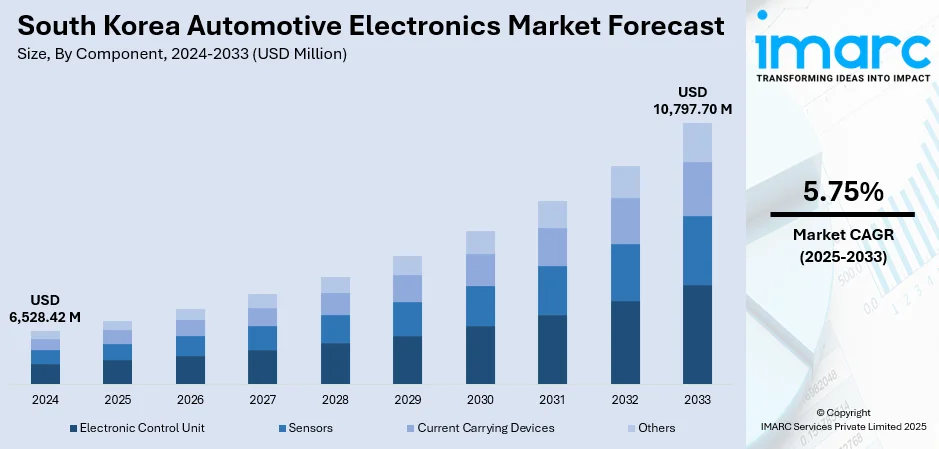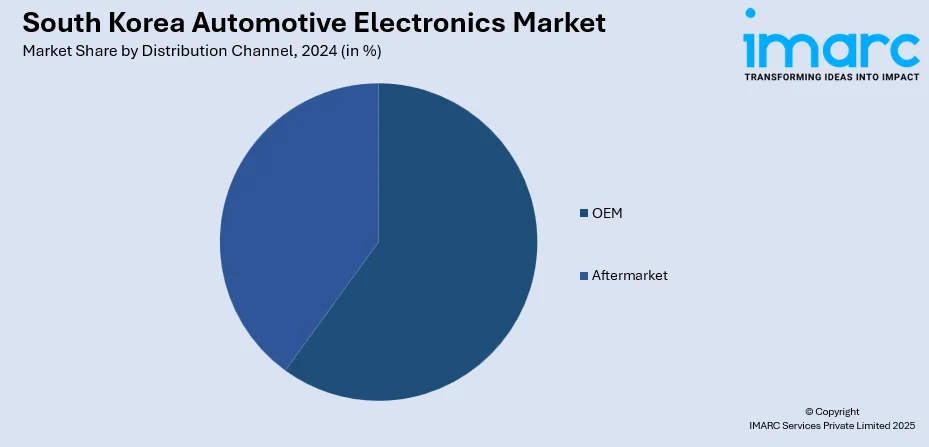
South Korea Automotive Electronics Market Size, Share, Trends and Forecast by Component, Vehicle Type, Distribution Channel, Application, and Region, 2025-2033
South Korea Automotive Electronics Market Overview:
The South Korea automotive electronics market size reached USD 6,528.42 Million in 2024. The market is projected to reach USD 10,797.70 Million by 2033, exhibiting a growth rate (CAGR) of 5.75% during 2025-2033. The market is experiencing steady growth, driven by rising demand for advanced vehicle technologies like autonomous driving systems and infotainment solutions. This trend is expected to significantly boost South Korea automotive electronics market share, particularly in the electric vehicle and smart automotive segments.
|
Report Attribute
|
Key Statistics
|
|---|---|
|
Base Year
|
2024
|
|
Forecast Years
|
2025-2033
|
|
Historical Years
|
2019-2024
|
| Market Size in 2024 | USD 6,528.42 Million |
| Market Forecast in 2033 | USD 10,797.70 Million |
| Market Growth Rate 2025-2033 | 5.75% |
South Korea Automotive Electronics Market Trends:
Increasing Focus on Autonomous Vehicle Technology
The South Korea automotive electronics market growth is driven by the development of autonomous vehicle technologies. Companies in the region are increasingly investing in advanced automotive electronics to deliver safer and more efficient driving experiences. The integration of autonomous driving systems and semiconductor solutions is driving innovation within the sector. In December 2024, Hyundai Motor and Samsung Electronics announced their collaboration to develop autonomous vehicle chips. The strategic alliance will use Samsung's 5-nanometer foundry to mass-produce automotive semiconductors for Hyundai's autonomous driving projects to provide a stable and consistent supply. As autonomous driving technology advances around the world, South Korea is standing at the forefront through its semiconductor production capacity improvements to satisfy the increasing demand for autonomous systems. The emphasis on future-generation chips and AI-related technologies is driving the nation's automotive sector towards more advanced solutions, further adding to the competitive edge for local automakers. The partnership marks the significance of pursuing the advancement of sophisticated semiconductor solutions and infrastructure to enable South Korea's future vision of autonomous vehicles.

To get more information on this market, Request Sample
Transformation in Vehicle Display Expertise
The automotive industry in South Korea is undergoing a significant transformation with an emphasis on enhancing user experience (UX) through innovative vehicle display technologies. South Korean manufacturers are exploring new ways to integrate advanced technologies to create smarter, safer, and more intuitive driving experiences. In October 2024, ZEISS and Hyundai Mobis announced a partnership to develop a Transparent Windshield Display using holographic technology. This breakthrough innovation aims to provide drivers with real-time, clear information without obstructing their view of the road, marking a major step forward in automotive display technology. This advanced display technology is set to revolutionize the in-vehicle experience, improving safety and comfort for drivers. The introduction of such cutting-edge technology is expected to have a significant impact on South Korea’s automotive electronics market, as local automakers increasingly prioritize next-generation infotainment systems and enhanced vehicle safety features. As global innovators like ZEISS and Hyundai Mobis push the boundaries of automotive displays, South Korea is poised to adopt similar advancements, solidifying its position in the global automotive electronics market. This collaboration highlights the growing importance of UX-focused technologies in shaping the future of automotive electronics in the country.
South Korea Automotive Electronics Market Segmentation:
IMARC Group provides an analysis of the key trends in each segment of the market, along with forecasts at the country and regional level for 2025-2033. Our report has categorized the market based on component, vehicle type, distribution channel, and application.
Component Insights:
- Electronic Control Unit
- Sensors
- Current Carrying Devices
- Others
The report has provided a detailed breakup and analysis of the market based on the component. This includes electronic control unit, sensors, current carrying devices, and others.
Vehicle Type Insights:
- Light Commercial Vehicles
- Passenger Vehicles
- Heavy Commercial Vehicles
- Others
A detailed breakup and analysis of the market based on the vehicle type have also been provided in the report. This includes light commercial vehicles, passenger vehicles, heavy commercial vehicles, and others.
Distribution Channel Insights:

- OEM
- Aftermarket
A detailed breakup and analysis of the market based on the distribution channel have also been provided in the report. This includes OEM and aftermarket.
Application Insights:
- ADAS
- Infotainment
- Body Electronics
- Safety Systems
- Powertrain
A detailed breakup and analysis of the market based on the application have also been provided in the report. This includes ADAS, infotainment, body electronics, safety systems, and powertrain.
Regional Insights:
- Seoul Capital Area
- Yeongnam (Southeastern Region)
- Honam (Southwestern Region)
- Hoseo (Central Region)
- Others
The report has also provided a comprehensive analysis of all the major regional markets, which include Seoul Capital Area, Yeongnam (Southeastern Region), Honam (Southwestern Region), Hoseo (Central Region), and others.
Competitive Landscape:
The market research report has also provided a comprehensive analysis of the competitive landscape. Competitive analysis such as market structure, key player positioning, top winning strategies, competitive dashboard, and company evaluation quadrant has been covered in the report. Also, detailed profiles of all major companies have been provided.
South Korea Automotive Electronics Market News:
- July 2025: LG Group advanced its position in automotive electronics by holding a Tech Day event in Tokyo with Honda. This event showcased LG's automotive electronics portfolio, including infotainment systems, displays, and EV batteries, strengthening its role in the growing software-defined vehicle market.
- June 2025: Motherson Group announced a joint venture with South Korea's Egtronics to develop vehicle power electronics, including DC-DC converters and inverters. This partnership, with Motherson holding a 51% stake, is expected to strengthen the automotive electronics sector, enhancing product offerings for trucks and buses.
South Korea Automotive Electronics Market Report Coverage:
| Report Features | Details |
|---|---|
| Base Year of the Analysis | 2024 |
| Historical Period | 2019-2024 |
| Forecast Period | 2025-2033 |
| Units | Million USD |
| Scope of the Report |
Exploration of Historical Trends and Market Outlook, Industry Catalysts and Challenges, Segment-Wise Historical and Future Market Assessment:
|
| Components Covered | Electronic Control Unit, Sensors, Current Carrying Devices, Others |
| Vehicle Types Covered | Light Commercial Vehicles, Passenger Vehicles, Heavy Commercial Vehicles, Others |
| Distribution Channels Covered | OEM, Aftermarket |
| Applications Covered | ADAS, Infotainment, Body Electronics, Safety Systems, Powertrain |
| Regions Covered | Seoul Capital Area, Yeongnam (Southeastern Region), Honam (Southwestern Region), Hoseo (Central Region), Others |
| Customization Scope | 10% Free Customization |
| Post-Sale Analyst Support | 10-12 Weeks |
| Delivery Format | PDF and Excel through Email (We can also provide the editable version of the report in PPT/Word format on special request) |
Key Questions Answered in This Report:
- How has the South Korea automotive electronics market performed so far and how will it perform in the coming years?
- What is the breakup of the South Korea automotive electronics market on the basis of component?
- What is the breakup of the South Korea automotive electronics market on the basis of vehicle type?
- What is the breakup of the South Korea automotive electronics market on the basis of distribution channel?
- What is the breakup of the South Korea automotive electronics market on the basis of application?
- What is the breakup of the South Korea automotive electronics market on the basis of region?
- What are the various stages in the value chain of the South Korea automotive electronics market?
- What are the key driving factors and challenges in the South Korea automotive electronics market?
- What is the structure of the South Korea automotive electronics market and who are the key players?
- What is the degree of competition in the South Korea automotive electronics market?
Key Benefits for Stakeholders:
- IMARC’s industry report offers a comprehensive quantitative analysis of various market segments, historical and current market trends, market forecasts, and dynamics of the South Korea automotive electronics market from 2019-2033.
- The research report provides the latest information on the market drivers, challenges, and opportunities in the South Korea automotive electronics market.
- Porter's Five Forces analysis assists stakeholders in assessing the impact of new entrants, competitive rivalry, supplier power, buyer power, and the threat of substitution. It helps stakeholders to analyze the level of competition within the South Korea automotive electronics industry and its attractiveness.
- Competitive landscape allows stakeholders to understand their competitive environment and provides an insight into the current positions of key players in the market.
Need more help?
- Speak to our experienced analysts for insights on the current market scenarios.
- Include additional segments and countries to customize the report as per your requirement.
- Gain an unparalleled competitive advantage in your domain by understanding how to utilize the report and positively impacting your operations and revenue.
- For further assistance, please connect with our analysts.
 Request Customization
Request Customization
 Speak to an Analyst
Speak to an Analyst
 Request Brochure
Request Brochure
 Inquire Before Buying
Inquire Before Buying




.webp)




.webp)












